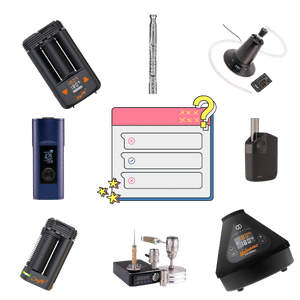It’s one of the most unclear and controversial topics in dry herb vaping:
Choosing the best temperature to vape weed.
It turns out, there is no single best temperature to vape weed.
The best temperature to vape weed is dependent on what effects you’re looking for. But it oscillates between 320°F(160°C) and 446°F(230°C).
In today’s post, I’m going to show you exactly what temperature is best for achieving your desired effects.
Changes in your vaporizer temperature can change the chemicals inside your vapor.
The active chemicals inside your vapor decide the:
- medical effects, and,
- taste,
of your cannabis vapor.
Before we continue:
Always keep in mind that your strain has the biggest impact on the effects and taste of your vapor. But more on that later.
Get started below with our simple quick guide:
- 320°F(160°C) – 356°F(180°C): Very light mostly mental medication and best for flavor (great if you still have a lot to do that day);
- 356°F(180°C) – 392°F(200°C): Great flavor with good medication level, bodily effects will be more clear;
- 392°F(200°C) – 446°F(230°C): Best if you don’t have anything else to do that day. Very strong level of medication, heavy physical effects.
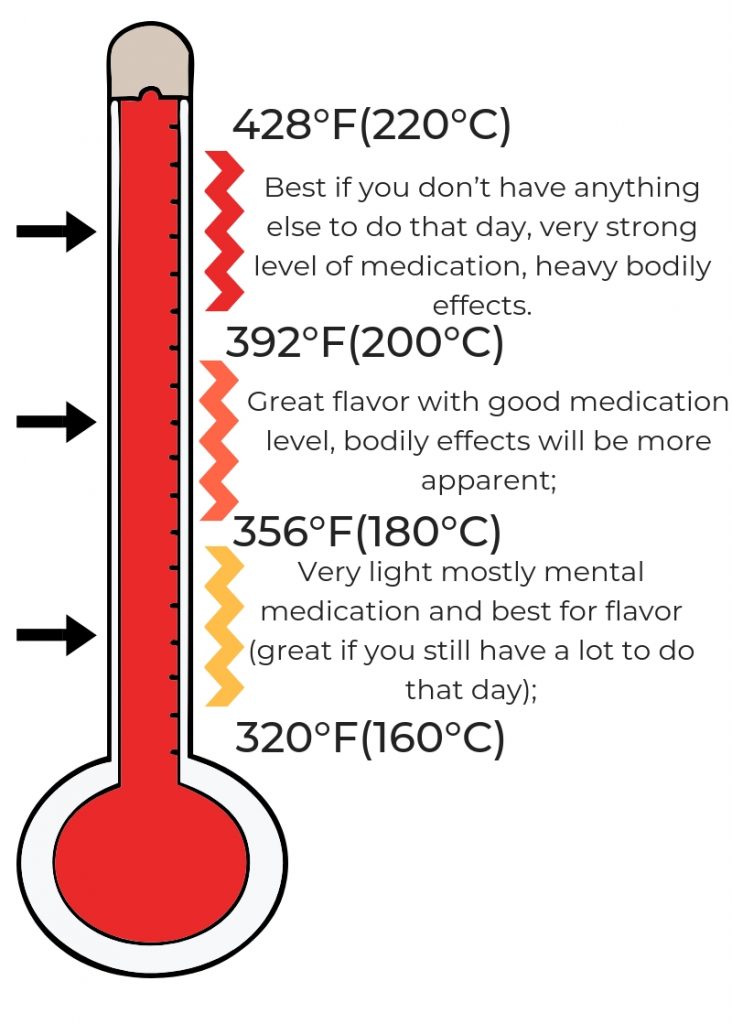
Table of contents:
The Chemical Structure & Medical Effects of Cannabis Explained
How Do Temperatures Impact Your Vaping Experience?
The 5 Stereotypical Cannabis Users and What Temperatures They Should Vape At
Dry Herb Vaporizers With Most Accurate Temperature Control
Specific Cannabis Compounds, Their Boiling Points, and Effects
The Chemical Structure and Pharmacological Effects of Cannabis Explained
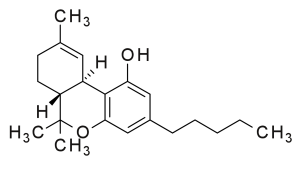
If there’s one cannabinoid that everyone seems to know it must be THC. Cannabis often gets equalized with THC.
But what most people don’t know is that the cannabis plant contains over 70 known cannabinoids. THC is just one of them (1).
Why does this matter?
Each cannabinoid has its own chemical structure and pharmacological effects. On top of 70+ cannabinoids, the cannabis plant contains many other types of compounds like:
- 120 different terpenoids, and;
- 23 different flavonoids.
Terpenoids and flavonoids have their own chemical structure and pharmacological effects as well.
Each cannabinoid, terpenoid, and flavonoid has unique effects.
To complicate things further:
Studies suggest that all compounds in cannabis influence each other’s effects. Sometimes they enhance each other’s medical effects. And sometimes they mitigate each other’s side-effects (2).
Cannabis is a ‘synergistic shotgun’. Hundreds of different compounds work together to produce a variety of pharmacological effects.
In short:
Don’t reduce Cannabis to one single cannabinoid (THC). The Cannabis plant is a very complex plant. It contains thousands of different compounds that all have their unique effects.
We always want to simplify things. But simplifying the cannabis plant to THC, will hinder you in finding your best vaping temperature.
Vaporizer Finder: Answer a Few Questions and Let Us Find the Best Vaporizer for You in Less Than a Minute
Yes, I Want to Find the Best Vaporizer for My Specific Situation →
How Do Temperatures Impact Your Vaping Experience?
All these:
- cannabinoids,
- terpenoids, and,
- flavonoids,
inside the Cannabis plant have different boiling points.
At certain temperatures, certain compounds will be boiling primarily.
For example:
To get high concentrations of CBD inside your vapor, you want to vape above 356°F(180°C). This doesn’t mean that a lower temperature won’t release any CBD. But it does mean you won’t release all CBD.
The chemicals and ratios of these chemicals inside your vapor will differ based on the compounds that are boiling at that time.
This leads us to the next point:
So the effects of your vapor start with you strain.
First, you have to find a strain that has a:
- cannabinoid-, and,
- terpene-profile,
that matches your desires.
And only after finding your perfect strain, you can determine the best temperature to vape at.
What do you want to achieve while vaping your herb?
To give some examples:
- You could be a medical user who’s looking for the painkilling (analgesic) effects of cannabis;
- You could be a recreational user whose goal is to go for mainly the euphoriant effects.
Depending on your goal, you want your vapor to have a particular chemical makeup. You can achieve this by maximizing or reducing particular compounds inside your vapor.
And you can control the release of these compounds with specific temperatures.
Generally speaking:
- Lower temperatures will release predominantly THC and little of the minor cannabinoids like CBD, CBG, CBN, and CBC. This means that at lower temperatures you’ll mostly experience a mental effect.
- With most cannabis strains, higher temperatures (above 200°C) will also release predominantly THC. But there will also be a release of minor cannabinoids like CBD, CBG, CBN, and CBC. This means that at higher temperatures, you’ll experience both a strong mental and physical effect.
You always have to keep in mind that most cannabis plants have very high concentrations of D9-THC and only low concentrations of other cannabinoids like CBD, CBN, and CBC.
So with most cannabis plants, you’ll always be predominantly releasing THC, no matter the temperature. So the mental effect will always be there, no matter the temperature.
Below you’ll find a simple guideline:
- 320°F(160°C) – 356°F(180°C): Very light mostly mental medication and best for flavor (great if you still have a lot to do that day);
- 356°F(180°C) – 392°F(200°C): Great flavor with good medication level, bodily effects will be more clear;
- 392°F(200°C) and up: Best if you don’t have anything else to do that day, very strong level of medication, heavy bodily effects.
320°F(160°C) – 356°F(180°C)
In this temperature range, you’ll mostly be inhaling THC. Minor cannabinoids like CBD, CBG, and CBC will be largely absent.
This doesn’t mean that the ‘physical’ cannabinoids and terpenoids like:
- CBD, CBN,
- linalool, and,
- α-terpineol,
aren’t present at all.
THC is the psychoactive cannabinoid in cannabis. It’s responsible for the ‘high’.
Also, the speed of extraction within this range, won’t be as high as in the higher temperature ranges. Your vapor won’t hit as hard.
You will get a light mostly mental medication, which is great if you still have a lot to that day.
It’s also the best temperature range for flavor preservation. And the best temperature range to really taste your herb without any harshness. Especially if you don’t have any built-in or external cooling mechanism like a bubbler.
356°F(180°C) – 392°F(200°C)
In this range, you will have a balanced ratio of the type of cannabinoids that have an effect on your mind and body.
The ‘physical’ cannabinoids and terpenoids like:
- CBD, CBN,
- linalool, and,
- α-terpineol,
will start to be a bigger part of the total.
But remember that to get high amounts of CBD, it’s important you vape a high-CBD strain. If you vape a regular high-THC strain, chances are you won’t be getting much CBD, no matter the temperature.
In this range, you will experience stronger mental effects. Because the speed of THC extraction will be higher than in the lower temperatures. It can be too much if you still have a lot to do that day. You will inhale more THC in a shorter period of time at this temperature range.
The bodily effects will also be more clear: you might get a bit of a lethargic feeling.
This is also dependent on your strain and how well your marijuana is cured. Oxidized cannabis has higher levels of CBN. CBN is thought to be one of the most sedative cannabinoids.
The vapor quality usually stays well in this temperature range. Only vaporizers with a short vapor path can make you experience some harshness. Vapor quality refers to the smoothness and flavor of your vapor.
392°F(200°C) – 446°F(230°C)
In this range, you will inhale a lot of THC, in a short period of time. But if your strain has a high concentration of the ‘physical’ cannabinoids and terpenes:
- CBD,
- CBC,
- CBG,
- CBN,
- linalool, and,
- α-terpineol,
you’ll also start inhaling these compounds in large quantities.
The effects will have a strong physical aspect to it, which is great if you don’t have anything to do that day.
But your mental medication can also be more intense here. Because the speed of THC-extraction will be FAST in this temperature range. You will inhale even more THC in a shorter period of time at this temperature range. Your vapor will pack a real punch.
Flavor might deteriorate in this temperature-range: it can get harsh. This is highly dependent on your vaporizer and vaping setup. Some vaporizers have built-in cooling mechanism. If not, I highly recommend using a bubbler in this temperature range.
Important note:
Realize that when you vape above 392°F(200°C), you risk inhaling significantly more benzene (4). Less than you would smoking, but still something to consider the health-conscious vapers.
The 5 Stereotypical Cannabis Users and Their Best Temperature to Vape Weed
- The Medical User
- The Healthy Super-Stoner
- The High-Class Connoisseur
- The Explorer of Consciousness
- The Social Party Animal
1. The Medical User
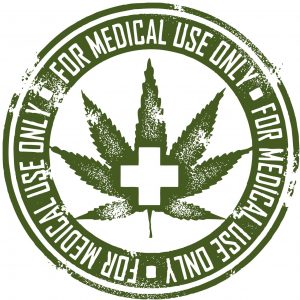 The medical user vapes cannabis for its medicinal properties. Maybe you’re someone with one of the following conditions:
The medical user vapes cannabis for its medicinal properties. Maybe you’re someone with one of the following conditions:
- nausea and vomiting,
- appetite loss,
- spasticity,
- pain,
- movement disorders,
- headache/migraine,
- epilepsy,
- asthma,
- autoimmune diseases and inflammation,
- psychiatric symptoms (anxiety, sleep disorders, bipolar disorders, etc.),
and vaping cannabis helps you with your condition.
The psychoactive effects of cannabis are a welcome or unwelcome side-effect for you. Definitely not the main reason why you’re vaping medical marijuana.
You really use cannabis as a medicine, not as some recreational tool to get you in higher spheres.
What you’re looking for is a combination of:
- the most powerful medical compounds, and,
- anything that reduces the consciousness- and mind-altering effects of THC.
What will be my most important compounds as a medical user?
Cannabinoids:
- CBD
- THC
- CBG
- CBN
- THCV
Terpenoids:
- caryophyllene
- linalool
- myrcene
The most important cannabinoids for you will be CBD and THC, and then all the other cannabinoids.
Both CBD and THC are well-researched cannabinoids with proven medicinal properties (5).
Having CBD in your vapor is also important because it reduces the side-effects of THC (such as anxiety) (6).
With CBD, you can consume more THC, without experiencing strong side effects.
But if you want CBD inside your vapor, you have to get a high-CBD strain. Regular cannabis strains don’t have much CBD.
If your herb has low levels of CBD, the temperature you vape at won’t have much effect on the total CBD inside your vapor.
Although not as well-researched as CBD and THC…
CBG and CBN also have many, sometimes even unique medicinal properties.
If you want to see a list of cannabis compounds with attributed medical properties, scroll down towards the end.
THCV reduces the consciousness- and mind-altering effects of THC (7). THCV also has strong anti-epileptic properties. If your strain has noteworthy levels of THCV, you should go high enough to release most of it.
But there are also terpenoids with many health benefits.
For example:
- caryophyllene,
- linalool, and,
- myrcene,
have pain-relieving, anti-anxiety, analgesic (painkilling), antidepressant, and sedative effects (8).
Terpenes are often overlooked when talking about the medical effects of cannabis. But studies suggest that terpenes have an important role in cannabis synergy.
What temperature should you set your vaporizer as a medical user?
- As a medical user, the optimal vaping temperature should be at around 392°F(200°C).
The boiling point of CBD is 320°F( 160°C) – 356°F(180°C). The boiling point of THC is 315°F(157°C). So you would think just go for a temperature of at least 356°F(180°C).
But one study found that the highest yield of CBD in Cannabis vapor was found at 446°F(230°C) (9).
This, however, is a risky temperature because of two reasons:
- The risk of combusting your herb will be high at this temperature (combustion can start after 446°F / 230°C)
- When you vape above 392°F(200°C) you risk inhaling benzene and other toxic by-products. Less than smoking, but still something to consider (4).
I advise against vaping at 446°F(230°C). Instead, don’t go above 392°F(200°C). The only exception is if you want to extract 100% of cannabinoids as fast you can, then you need to go as high as you can.
2. The Healthy Super-Stoner
 You’re a stoner, but a health-conscious one, that’s why you vaporize instead of smoke.
You’re a stoner, but a health-conscious one, that’s why you vaporize instead of smoke.
You like to get baked and get baked WELL.
You’re looking for euphoriant effects and a sedative tingling feeling all over your body.
Whether you do it with friends or solo, you like to chill to the maximum when vaping. Stack up your provisions with some good stoner foods. Get a bunch of new movies, games, or series. And just get totally sucked in and lose yourself in your entertainment.
What you’re looking for is a combination of euphoriant and sedative physical effects.
What will be my most important compounds?
Cannabinoids:
- THC
- CBD
- CBN
Terpenoids:
- linalool
- α-terpineol
The most important cannabinoid for you will be THC, but you’ll want some CBD as well. And for that sedative tingling feeling, you’re going to need:
- CBN, and,
- terpenes myrcene, linalool and α-terpineol.
Here’s why:
THC will get you into that euphoriant state generally called the ‘high’. So you really want to maximize the THC in your vapor.
But THC has the potential to provoke some side-effects like anxiety and paranoia. CBD helps to counteract these effects.
CBN, linalool, and α-terpineol have potent sedative effects.
What temperature should you set your vaporizer as a healthy super-stoner?
- As a healthy super-stoner, the optimal vaping temperature should be at around 392°F(200°C).
This definitely is high enough to vaporize all THC. And it’s also high enough to get a decent amount of CBD, CBN, linalool, and α-terpineol.
If you go higher you risk inhaling benzene and other toxic by-products.
But you also risk reducing the euphoric effects of THC with the release of THCV.
Lastly, if you higher, the ratio of cannabinoids skews towards CBD and CBN. This means you the sedative, physical effects may dominate the euphoriant effects.
3. The High-Class Cannabis Connoisseur
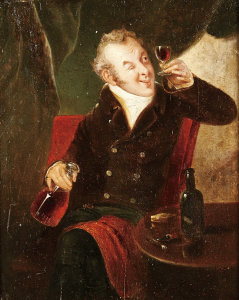 As a high-class connoisseur, you prioritize the flavor of cannabis.
As a high-class connoisseur, you prioritize the flavor of cannabis.
Flavor above all else is your mantra.
Any psychoactive, physical, or medical effects are secondary to flavor.
A vaping session for is good when terpenes bless your taste buds with full flavor. You sit back, take it slow and just lose yourself in that amazing taste. Anything else is just a nice bonus.
What will be my most important compounds?
- All terpenoids
The most important type of compound for you will not be cannabinoids, but, terpenoids!
Terpenoids are responsible for the unique smell and taste of cannabis.
Cannabis has over 120 known terpenoids. And most of them have a boiling point around the same temperature as THC: 315°F(157°C).
What temperature should you set your vaporizer as a high-class connoisseur?
- As a cannabis connoisseur, the optimal vaping temperature should be at around 356°F(180°C).
So why go higher than 315°F(157°C)?
Because to get to the most well-researched terpenoids, you will have to go as far as 356°F(180°C).
You will actually start to notice that if you go higher than this, the flavor of your vapor can deteriorate. With the general rule:
- The higher you go with the temperature, the more the flavor will deteriorate.
With 356°F(180°C), you will get most of the terpenoids for a full and intense blast of flavors. But without any harshness that comes from vaping at high temperatures.
There’s no one single terpenoid that contributes most to the taste of marijuana so don’t go searching for ‘the one’.
On a side-note, the temperature is just one of the many variables that have a decisive impact on the taste of your vapor.
Check out our guide on how to maximize potency and flavor for all the other variables.
4. The Explorer of Consciousness
 The explorer of consciousness uses cannabis for artistic or spiritual adventures.
The explorer of consciousness uses cannabis for artistic or spiritual adventures.
Its consciousness- and mind-altering properties are what draws you to cannabis.
When vaping you’re either looking for a jolt of creativity, expanding the boundaries of your imagination. Or you want to achieve states of consciousness that help you get into a deep meditation session.
Either way, you want powerful consciousness- and mind-altering effects. But without feeling groggy or getting into a lazy and lethargic mood. Just a powerful but clean and clear effect.
What will be my most important compounds?
Cannabinoids:
- THC
- CBD
Terpenoids:
- caryophyllene
- limonene
- myrcene
For you, the most important cannabinoid will be THC. This cannabinoid is responsible for the psychoactive effects created by using cannabis.
But as said before, the cannabis plant is a ‘synergistic shotgun’. So you want all the compounds that synergize and enhance the positive effects of THC. Or reduce the negative effects of THC in your vapor as well.
So which ones are these?
First of all, you definitely want CBD in your vapor.
Because here’s the deal:
CBD helps counter all the negative side-effects associated with THC, like:
- anxiety,
- hunger, and,
- sedation (6).
But you also want some terpenoids in there. And then specifically, those with anti-anxiety effects: myrcene, caryophyllene, and limonene.
Here’s why:
Yes, you want the strong consciousness- and mind-altering effects of THC. But THC has the potential to provoke effects like anxiety, restlessness, and paranoia. These emotions will negatively impact the clarity of your high.
Mycrene, caryophyllene, and limonene have calming and anxiety-reducing effects (10, 11, 12)
You really can’t have that, because you want to ENHANCE your perception. Not dull it by being stuck in your head with paranoid thoughts.
What temperature should you set your vaporizer as an explorer of consciousness?
- As an explorer of consciousness, the optimal vaping temperature should be at around 365°F(185°C).
The explorer of consciousness should go high enough to vaporize most of the THC. And according to one study this point is at 365°F(185°C) (13).
Also high enough to get a decent amount of CBD and terpenoids with anti-anxiety effects.
But low enough to keep the compounds that reduce the psychoactive effects of THC, like THCV, to a minimum.
Also, you don’t want to get into a couch-lock or experience feelings of lethargy.
How you avoid this is by keeping the temperature below 365°F(185°C): the boiling point of CBN. This is the cannabinoid with most potent sedative effects. This way, you also reduce sedative terpenoids like linalool and α-terpineol.
5. The Social Party Animal
 The social party animal likes to vape cannabis on social occasions. At parties, while going out, or just at general social gatherings.
The social party animal likes to vape cannabis on social occasions. At parties, while going out, or just at general social gatherings.
An energetic, euphoriant, clear high is what he/she is after.
A lazy lethargic couch-lock session is a dreadful happening.
Feelings of anxiety and paranoia are especially detrimental to your experience. Because these are some of the worst anti-social feelings.
You want the euphoriant effects without ANY of the negative side-effects of cannabis.
What will be my most important compounds?
Cannabinoids:
- THC
- CBD
Terpenoids:
- caryophyllene
- myrcene
You’re looking for the euphoriant effects of cannabis. So your most important cannabinoid is THC.
But that’s not all.
Like the explorer of consciousness, you want to reduce side-effects like anxiety and paranoia.
You already know how to achieve this:
Get a decent amount of CBD in your vapor, THE go-to cannabinoid to counter all the negative side effects of THC.
On top of the CBD get the terpenoids known to have anti-anxiety effects in there:
- myrcene,
- caryophyllene, and,
- limonene.
With this cocktail of cannabinoids and terpenes you’ll have a:
- energetic,
- euphoriant, and,
- clear-headed high.
Plus, you’ll reduce the risk of paranoia or anxiety.
At the same time, you want to reduce:
- CBN,
- linalool, myrcene and α-terpineol.
These are the compounds that can give that sedative tingling feeling in your body. They can put you in that dreaded couch-lock.
What temperature should you set your vaporizer as a social party animal?
- As a social party-animal, the optimal vaping temperature should be at around 356°F(180°C).
The social party animal should go high enough to vaporize all THC. And high enough to get a decent amount of CBD and the terpenoids with anti-anxiety effects.
But low enough to keep the compounds that reduce the euphoriant effects of THC to a minimum. Compounds like THCV.
Also, you want to avoid couch-lock or experience feelings of lethargy.
How you avoid this is by keeping the temperature below 365°F(185°C): the boiling point of CBN.
This is the cannabinoid which is thought to be primarily responsible for the sedative effects of cannabis. You will also keep the vaporization of the sedative terpenoids: linalool and α-terpineol, at a minimum this way.
Dry Herb Vaporizers With Most Accurate Temperature Control
Now that you know your best temperature to vape your weed at, there’s something you need to know.
All dry herb vaporizers have some sort of temperature control.
But here’s the catch:
Not every vaporizer has got accurate temperature control.
Most vaporizers measure the temperature of the heating element. But the temperature of the heating element usually isn’t the same as the temperature of your herb. And the difference can be quite big depending on your vaporizer.
Now:
I can give you any type of temperature advice. But if your vaporizer hasn’t got accurate temperature control, you’re shooting in the dark.
To get a vaporizer with accurate temperature to even 1 degrees control look for the following features:
- Digital temperature control, or,
- A heating algorithm that keeps the temperature in your bowl consistent when drawing vapor;
For recommendations, you should check out the vaporizers in the following articles:
But more importantly…
Avoid these:
- Any vaporizer that’s not from a reputable brand or authorized dealer. This includes vaporizers from eBay, Alibaba, and other auction types of websites. Please just avoid these vaporizers in general, they can be a disaster to your health;
- Any conduction vaporizer (like the PAX 2, MFLB). Conduction heating doesn’t distribute the heat evenly. Your temperature will not be consistent all the time;
- Any fixed temperature vaporizer;
Specific Cannabis Compounds, Their Boiling Points, and Effects
Below you’ll find a list of the most well-known cannabinoids, terpenes and flavonoids, their boiling points, and their main beneficial effects.
Keep in mind that every compound will start releasing at temperatures below its boiling point. And the longer your herb is cooking, the more of it will release (even when the temperature is below the boiling point).
Just if you want a major release of a specific compound, you have to set the temperature of your vaporizer at least to its boiling point.
Cannabinoids
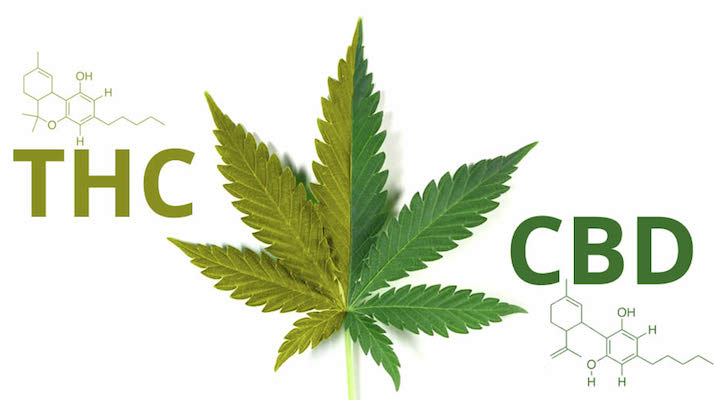
Cannabinoids are the compounds that make the effects of cannabis unique. Even though there are over 70 plus known, six of them, ‘The Big 6’, are well researched. THC is definitely the most well researched, and more and more research is going into CBD.
Below you’ll find the ‘The Big 6’, their boiling points, and their effects:
| Cannabinoid | Boiling Point | Effects |
|---|---|---|
| Δ-9-THC | 315°F / 157°C | Euphoriant Analgesic Antiinflammatory Antioxidant Antiemetic |
| CBD | 320°F – 356°F / 160°C -180°C | Anxiolytic Analgesic Antipsychotic Antiinflammatory Antioxidant Antispasmodic |
| CBN | 365°F / 185°C | Oxidation breakdown product Sedative Antibiotic |
| CBC | 428°F / 220°C | Antiinflammatory Antibiotic Antifungal |
| CBG | 220°F / 105°C | Antiinflammatory Antibiotic Antifungal |
| THCV | 428°F / 220°C | Analgesic Euphoriant |
Source: Cannabis and Cannabis Extracts: Greater Than the Sum of Their Parts? (13)
Terpenoids

You know that smell that some people absolutely swear by and others immediately associate with negative things…?
Terpenoids are responsible for that characteristic taste and smell of cannabis. But they have many other (medicinal) properties and synergize with all the other compounds in cannabis, like cannabinoids, as well (8).
Below you’ll find the most well-researched terpenoids in cannabis. Including their boiling points, and their effects:
| Terpenoid | Boiling Point | Effects |
|---|---|---|
| β-myrcene | 334°F / 168°C | Analgesic Antiinflammatory Antibiotic Antimutagenic |
| β-caryophyllene | 246°F / 119°C | Antiinflammatory Cytoprotective (gastric mucosa) Antimalarial |
| d-limonene | 351°F / 177°C | Cannabinoid agonist Immune potentiator Antidepressant Antimutagenic |
| linalool | 388°F / 198°C | Sedative Antidepressant Anxiolytic Immune potentiator |
| pulegone | 435°F / 224°C | Memory booster AChE inhibitor Sedative Antipyretic |
| 1,8-cineole (eucalyptol) | 349°F / 176°C | AChE inhibitor Increases cerebral blood flow Stimulant Antibiotic Antiviral Antiinflammatory Antinociceptive |
| α-pinene | 312°F / 156°C | Antiinflammatory Bronchodilator Stimulant Antibiotic Antineoplastic AChE inhibitor |
| α-terpineol | 424°F / 218°C | Sedative Antibiotic AChE inhibitor Antioxidant Antimalarial |
| terpineol-4-ol | 408°F / 209°C | AChE inhibitor Antibiotic |
| p-cymene | 351°F / 177°C | Antibiotic Anticandidal AChE inhibitor |
| borneol | 410°F / 210°C | Antibiotic |
| Δ-3-carene | 334°F / 168°C | Antiinflammatory |
Source: Cannabis and Cannabis Extracts: Greater Than the Sum of Their Parts? (13)
Flavonoids
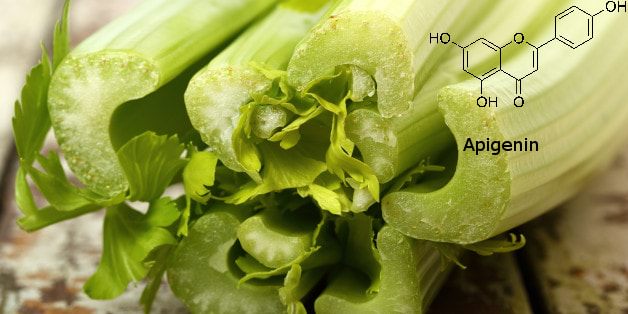
Although the name suggests differently…
Flavonoids are not the main contributors to the unique taste and smell of cannabis. But just like terpenoids, flavonoids do have many medicinal properties as well.
Below you’ll find the most well-researched flavonoids in cannabis. Including their boiling points, and their effects:
| Flavonoids | Boiling Point | Effects |
|---|---|---|
| apigenin | 352°F / 178°C | Anxiolytic Antiinflammatory Estrogenic |
| quercetin | 482°F / 250°C | Antioxidant Antimutagenic Antiviral Antineoplastic |
| cannflavin A | 360°F / 182°C | COX inhibitor LO inhibitor |
| β-sitosterol | 273°F / 134°C | Antiinflammatory 5-α-reductase inhibitor |
Source: Cannabis and Cannabis Extracts: Greater Than the Sum of Their Parts? (13)
What’s Next
Now that you know:
- the most important compounds in cannabis,
- how they impact your experience, and,
- their boiling temperatures,
you can tailor your vaping experience to your specific needs. Get the most out of each vaping session.
If you enjoyed this post and want more, please become a fan on Facebook or share this article.
Scientific References:
- ElSohly, M. A., & Slade, D. (2005). Chemical constituents of marijuana: The complex mixture of natural cannabinoids. Life Sciences, 78(5), 539–548. https://doi.org/10.1016/j.lfs.2005.09.011
- Wilkinson, J. D., Whalley, B. J., Baker, D., Pryce, G., Constanti, A., Gibbons, S., & Williamson, E. M. (2003). Medicinal cannabis: is Δ9–tetrahydrocannabinol necessary for all its effects? Journal of Pharmacy and Pharmacology, 55(12), 1687–1694. https://doi.org/10.1211/0022357022304
- Kumar, R. N., Chambers, W. A., & Pertwee, R. G. (2001). Pharmacological actions and therapeutic uses of cannabis and cannabinoids. Anaesthesia, 56(11), 1059–1068. https://doi.org/10.1046/j.1365-2044.2001.02269.x
- Gieringer, D. H. (2001). Cannabis “Vaporization.” Journal of Cannabis Therapeutics, 1(3–4), 153–170. https://doi.org/10.1300/j175v01n03_10
- Russo, E., & Guy, G. W. (2006). A tale of two cannabinoids: the therapeutic rationale for combining tetrahydrocannabinol and cannabidiol. Medical hypotheses, 66(2), 234–246. https://doi.org/10.1016/j.mehy.2005.08.026
- Hudson, R., Renard, J., Norris, C., Rushlow, W. J., & Laviolette, S. R. (2019). Cannabidiol Counteracts the Psychotropic Side-Effects of Δ-9-Tetrahydrocannabinol in the Ventral Hippocampus through Bidirectional Control of ERK1–2 Phosphorylation. The Journal of Neuroscience, 39(44), 8762–8777. https://doi.org/10.1523/jneurosci.0708-19.2019
- Englund, A., Atakan, Z., Kralj, A., Tunstall, N., Murray, R., & Morrison, P. (2015). The effect of five day dosing with THCV on THC-induced cognitive, psychological and physiological effects in healthy male human volunteers: A placebo-controlled, double-blind, crossover pilot trial. Journal of Psychopharmacology, 30(2), 140–151. https://doi.org/10.1177/0269881115615104
- Russo E. B. (2011). Taming THC: potential cannabis synergy and phytocannabinoid-terpenoid entourage effects. British journal of pharmacology, 163(7), 1344–1364. https://doi.org/10.1111/j.1476-5381.2011.01238.x
- Solowij, N., Broyd, S. J., van Hell, H. H., & Hazekamp, A. (2014). A protocol for the delivery of cannabidiol (CBD) and combined CBD and ∆9-tetrahydrocannabinol (THC) by vaporisation. BMC Pharmacology and Toxicology, 15(1). https://doi.org/10.1186/2050-6511-15-58
- Surendran, S., Qassadi, F., Surendran, G., Lilley, D., & Heinrich, M. (2021). Myrcene—What Are the Potential Health Benefits of This Flavouring and Aroma Agent? Frontiers in Nutrition, 8. Published. https://doi.org/10.3389/fnut.2021.699666
- Komiya, M., Takeuchi, T., & Harada, E. (2006). Lemon oil vapor causes an anti-stress effect via modulating the 5-HT and DA activities in mice. Behavioural Brain Research, 172(2), 240–249. https://doi.org/10.1016/j.bbr.2006.05.006
- Souto-Maior, F. N., Carvalho, F. L. de, Morais, L. C. S. L. de, Netto, S. M., de Sousa, D. P., & Almeida, R. N. de. (2011). Anxiolytic-like effects of inhaled linalool oxide in experimental mouse anxiety models. Pharmacology Biochemistry and Behavior, 100(2), 259–263. https://doi.org/10.1016/j.pbb.2011.08.029
- McPartland, J. M., & Russo, E. B. (2001). Cannabis and Cannabis Extracts. Journal of Cannabis Therapeutics, 1(3–4), 103–132. https://doi.org/10.1300/j175v01n03_08
